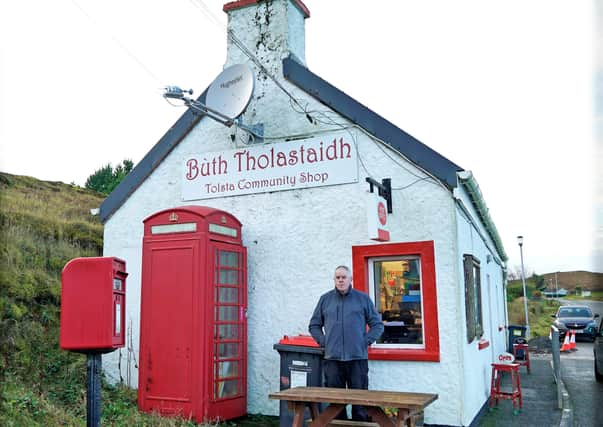Financial disaster for community wind farms


Nor can they make payments of their profits to local community trusts and development organisations, concerns have been raised in recent weeks that many key local charities and good-causes, that in recent years have come to rely on the grant schemes, are facing a very uncertain future.
This week Comhairle nan Eilean Siar announced that it had set-up an emergency fund - with £300k in funding from SSE, and £175k from its own resources - targeted at supporting the community groups and charities who have lost income, giving a glimmer of hope for some of those affected.
Advertisement
Hide AdAdvertisement
Hide AdThe Comhairle has confirmed that it aims to have full details of the emergency fund available by the end of this week.


But that fund cannot cover the revenues the wind farm companies themselves require to stay operational.
With transmission company SSEN confirming that a replacement of the subsea cable could take a year, the loss of income from electricity generation also means that the companies that own and operate the turbines are now facing huge uncertainties as to how they will maintain their equipment - which needs to operate to stay in good condition - and meet the large operational and finance overheads they have to keep the lights on.
Into the mix must also be thrown continuing uncertainties for the generators about the level - if any - of insurance payments they may or may not receive as a result of the failure or breakage of the sub-sea cable, with some local generators stating that so much depends on matters such as whether the sub-sea transmission cable was broken as a result of an accident or simply failed due to a deteriorated condition.
Advertisement
Hide AdAdvertisement
Hide AdThe worry for the generators is that one of these scenarios is covered, while the other may not be, so a lifeline from that source remains very firmly in the air.
Murdo MacIver, Director of Tolsta Community Development Ltd (TCDL) outlined this week the situation in the village, situated some fourteen miles from Stornoway, and what the loss of revenue to the community really means.
The single 900kw turbine on the outskirts of the village generated income of £580k for its owner and operator Tolsta Power Ltd, in the last year of completed accounts, with the £307k profits being gift-aided to TCDL.
Tolsta Power Ltd has now lost the income it requires to operate and pay for the overheads of the turbine, which, according to Mr MacIver was built with a mortgage loan of £1.6m and which has a twice a year payment schedule.
Advertisement
Hide AdAdvertisement
Hide AdMr MacIver said: “The Banks have been very good, they understand what has happened, and depending on progress with insurance they might give us a holiday on one of the payments of the mortgage. We find ourselves in a very awkward situation through no fault of our own.”
TCDL has now sent a letter to every household in the village confirming that situation and that its grants schemes, such as the winter fuel poverty vouchers that TCDL pays to 225 houses in the village, totalling £72k, have been suspended, as have payments to the elderly in the village for minor housing repairs, grants to students studying at home and on the mainland, to the local youth club, who are amongst a number of local organisations potentially set to miss out.
Outside of the village, TCDL has also made significant grants to Bethesda Care Home and Hospice as well as to other local care homes and the Lewis and Harris branch of Alzheimer Scotland.
But the focus now for Murdo and the board of TCDL is to secure the wages of the staff they employ, including a full-time post in the company’s office and the staffing of the village’s poly-tunnel project.
Advertisement
Hide AdAdvertisement
Hide AdMr MacIver continued: “We are trying to support the wages of staff and hopefully we will keep these going as long as possible.
“We have a reserves policy in place but we don’t want to start digging into that at the moment. As a company we have to carry on and keep our head above water somehow.
He concluded: “We find ourselves in an awkward situation, the majority of the village understand what is going on but there are others that didn’t realise that we were selling electricity to the grid and weren’t aware where the money was coming from.”
Another major concern for the village is the threat the loss of the TCDL grant monies poses to the local shop and post office, Buth Tholastaidh.
Advertisement
Hide AdAdvertisement
Hide AdThe building occupied by Buth Tholastaidh is owned by TCDL, but the business is run by a separate organisational committee, and TCDL pays £18k a year to them to assist the business to stay open.
Buth Tholastaidh currently employs one full-time and one part-time member of staff as well as having two volunteers who do deliveries throughout the village and a driver with a shop van for supplies.
Shop manger Dorothy MacIver highlights the central role the shop began to play during the Covid-19 pandemic lock-down, which saw footfall at the store and post office rapidly increase, and with it the shop’s stock and staff hours increased.
Ms MacIver said: “This wasn’t a viable business before. We are close enough to town with Tesco and the Co-op for people to go there, and that’s perfectly understandable. But in the lock-down that’s when we became really useful, and we were in a position to maybe encourage people not to go into town.
Advertisement
Hide AdAdvertisement
Hide Ad“For those who did not want to go into town we tried to keep everything they could possible want, far more than we would normally have in, and we still do orders for them on a Wednesday and a Friday. We have people who don’t leave the village now because they are worried, so we get everything for them.”
Ms MacIver said that the loss of the TCDL grant “is a big blow” for them, “and that basically has kept us going. We wouldn’t be here now, we would have folded if it wasn’t for that money.”
She added: “We have far more customers than we have ever had before, far more stock and far more staff hours than we had before. So we still need that TCDL payment, and it is going to get quieter. It’s natural, as everything begins to open up we are going to see people going back to their normal ways, and that’s natural. We will quieten down and will miss that money, but hopefully we have enough behind us now to keep going for a wee while longer.”
Loch a Tuath councillor, John A MacIver whose ward includes Tolsta, said: “We can only hope that the inter-connector is repaired and obviously replaced as soon as possible and that a cable, of the desired capacity, would be procured so that the islands could benefit from the huge resources that they can provide.”
Advertisement
Hide AdAdvertisement
Hide Ad“This seems to me to be the best way forward as having to rely on the current power station could prove to be disastrous given its age and type, and the ever increasing demand for more electricity.”
Community land trust, Urras Oighreachd Ghabhsainn (Galson Estate Trust) operates on the other side of Lewis’s northern tip to TCDL.
In a statement this week UOG also confirmed that it “had been dealt a major blow by the subsea cable failure,” and a spokesperson for the Estate confirmed that while income from wind energy generation varies from year to year depending on a range of factors such as wind speeds and market pricing, they would normally expect a minimum income of £250k.
A spokesperson for the Estate said: “Income to date has enabled Urras Oighreachd Ghabhsainn to build up reserves that will sustain key functions over a twelve month period, while the cable is being replaced.
Advertisement
Hide AdAdvertisement
Hide Ad“We are currently undertaking a review of income and expenditure and have postponed any decisions on grant applications until there is a better understanding of the timescale of the shutdown.”
But, the Estate’s spokesperson warned that turbine operating company, Galson Energy Ltd is facing “the most significant impact as it has lost its income but remains locked into ongoing financial obligations such as making loan payments”.
The Estate’s spokesperson concluded: “SSE has permitted turbines to operate at a low output meantime while discussions are underway about alternative arrangements. Community generators continue to work together to review various options that, if permitted by SSE, could enable turbines to operate at increased output in order to gain a more meaningful income until a replacement cable is laid.
“Clearly, some vital community services across the island have been adversely affected and Urras Oighreachd Ghabhsainn welcomes recent efforts by Comhairle nan Eilean Siar and SSE to launch an Emergency Support Fund that will alleviate financial distress for eligible organisations.”
Advertisement
Hide AdAdvertisement
Hide AdAgnes Rennie, Chair of Urras Oighreachd Ghabhsainn, commented: “It is clearly a challenging time for community generators and the implications of the cable failure need to be addressed carefully to strike the best balance between maintaining key functions and tailoring discretionary areas of activity to fit the financial constraints. This is not an easy process and we expect to return to this exercise again as the situation unfolds over the months ahead.”
On the west side of Lewis, Horshader Community Development (HCD) is a community-owned charitable trust established in May 2005 ‘to plan and run a community wind farm for the benefit of people in South Shawbost, Dalbeag and Dalmore’.
HCD states on its website that it was the first community group in the Western Isles to develop a renewable energy ‘revenue-generating project’, and now operates a 900kw turbine.
Flora MacLeod, Chair of Horshader Community Development (HCD) said: “The damage to the subsea cable, and the unclear timescale for repair, has left Horshader Community Development in an impossible position with regards to planning. “While our priority is protecting the workforce, and the grant schemes open to the community - project grants and bursaries for training and higher education – as far as possible, losing the majority of our annual income will force significant and damaging cuts to our budgets.”
Advertisement
Hide AdAdvertisement
Hide AdA spokesperson for HCD added: “The associated costs, and operational costs to maintain the turbine, as well as the bank loan payments, are a big concern. As per the news of the last few days, it’s possible we’ll receive some emergency grant funding to cover funds that would’ve been distributed to the wider community, but this doesn’t help us with our other turbine costs, or much of our annual overheads.
“We have yet to receive any assurances regarding our insurance claim, and even in the best case scenario (receiving the maximum award) we will lose a substantial part of our income over 2020/21. If the cable isn’t repaired in the 12 month period, we’ll struggle to survive.”
At the end of October Point and Sandwick Trust confirmed it could lose up to £2.5m in income from their the Beinn Ghrideag wind farm as a result of the failure of the subsea electricity transmission cable.